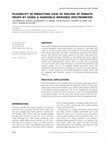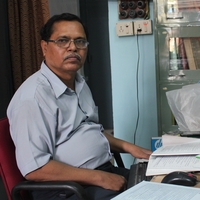Papers by Normand St-pierre
This presentation was given during the 71st Annual Convention of the 2017 Virginia State Feed Ass... more This presentation was given during the 71st Annual Convention of the 2017 Virginia State Feed Association Nutritional Management “Cow” College. This convention was held at The Hotel Roanoke and Conference Center in Roanoke, VA from February 15-16, 2017.

Translational Animal Science, 2020
Despite the important role of digesta mean retention time (MRT) on digestive efficiency of rumina... more Despite the important role of digesta mean retention time (MRT) on digestive efficiency of ruminants, it is poorly investigated in total gastrointestinal tract (GIT) of growing ruminants, especially in goats. The objective of this study was to evaluate the effect of body weight (BW) and sex on GIT MRT of particles and solutes in growing Saanen goats. A dataset from two studies, comprising 103 individual records of castrated males (n = 36), females (n = 34), and intact males (n = 33) Saanen goats slaughtered at 15, 22, 30, 37, and 45 kg BW, was used. Goats were fed basically with total mixed ration composed by dehydrated corn plant (Zea mays) milled to pass a 10-mm screen, cracked corn grain, and soybean (Glycine max) meal. Variables evaluated were BW, feed intake, feed intake level, composition of ingested diet, wet weight of GIT tissues, wet digesta pool size, digesta composition (dry matter and neutral detergent fiber [NDF]), indigestible NDF:NDF ratio of ingested diet and GIT dig...
Journal of Dairy Science, 2016
Sound design of experiments combined with proper implementation of appropriate statistical method... more Sound design of experiments combined with proper implementation of appropriate statistical methods for data analysis are critical for producing meaningful scientific results that are both replicable and reproducible. This communication addresses specific aspects of design and analysis of experiments relevant to the dairy sciences and, in so doing, responds to recent concerns raised in a letter to the editor of the Journal of Dairy Science regarding journal policy for research publications on pen-based animal studies. We further elaborate on points raised, rectify interpretation of important concepts, and show how aspects of statistical inference and elicitation of research conclusions are affected.

Revista Brasileira de Zootecnia, 2007
In certain areas of animal research, such as nutrition, quantitative summarizations of literature... more In certain areas of animal research, such as nutrition, quantitative summarizations of literature data are periodically needed. In such instances, statistical methods dealing with the analysis of summary data (generally from the literature) must be used. These methods are known as meta-analyses. The implementation of a meta-analysis is done in several phases. The first phase defines the study objectives and identifies the criteria for selecting prior publications to be used in the construction of the database. Publications must be scrupulously evaluated for their quality before being entered into the database. During this phase, it is important to carefully encode each record with pertinent descriptive attributes (experiments, treatments, etc.) to serve as important reference points later on. Statistically, databases from literature data are inherently unbalanced, leading to considerable analytical and interpretation difficulties. Missing data are frequent, and data are not the outcomes of a classical experimental system. A graphical examination of the data is useful in getting a global view of the system as well as to hypothesize specific relationships to be investigated. This phase is followed by a statistical study of the meta-system using the database previously assembled. The statistical model used must follow the data structure. Variance decomposition must account for inter-and intrastudy sources; dependent and independent variables must be identified either as discrete (qualitative) or continuous (quantitative). Effects must be defined as either fixed or random. Often observations must be weighed to account for differences in the precision of the reported means. Once model parameters are estimated, extensive analyses of residual variations must be performed. The roles of the different treatments and studies in the results obtained must be identified. Often, this requires returning to an earlier step in the process. Thus, meta-analyses have inherent heuristic qualities that can guide in the design of future experiments as well as aggregating prior knowledge into a quantitative prediction system.

Journal of Food Processing and Preservation, 2012
The potential of infrared (IR) handheld spectrometers, paired with chemometrics, to predict peela... more The potential of infrared (IR) handheld spectrometers, paired with chemometrics, to predict peelability of processing tomatoes was examined. A pilot plant scale study was carried out where tomato fruits underwent lye treatment and peeled with rotating rubber disks. The degree of peeling was regressed on the infrared spectral data collected from various regions on the fruits using partial least squares regression procedure. Peelability was best explained by spectra collected from areas adjacent to the blossom and stem ends. The regression model exhibited residuals with nonhomogeneous variance and was accurate only in predicting "very hard to peel" values, using IR frequencies associated with phenolics in the cuticular domain. The use of a handheld infrared spectrometer paired with chemometrics showed promise for predicting ease of peel of processing tomatoes. There is a need to improve spectral quality through better sample contact with the attenuated total reflectance accessory for predicting intermediate-peeling tomatoes. PRACTICAL APPLICATIONS The tomato industry incurs in significant losses during the peeling stage, accounting for up to 28% of the waste generated in commercial canneries. Current technology used to assess tomato maturity (color, soluble solids, titratable acidity) has not correlated to tomato-peeling losses. The use of a handheld IR spectrometer paired with chemometrics has shown potential as a tool for predicting peelability of processing tomatoes. We have shown that infrared spectra reflect the peel's chemical state, which in turn could be related to the fruit's developmental stage.

Journal of Animal Science, 2011
High ambient temperature (T) is one of the most important climatic factors influencing pig perfor... more High ambient temperature (T) is one of the most important climatic factors influencing pig performance. Increased T occurs sporadically during summer heat waves in temperate climates and year round in tropical climates. Results of published experiments assessing the effects of high T on pig performance are surprisingly variable. Thus, a meta-analysis was performed to aggregate our knowledge and attempt to explain differences in the results across studies on the effect of increased T on ADFI and ADG in growing-finishing pigs. Data for ADFI and ADG were extracted from 86 and 80 trials, respectively, from articles published in scientific journals indexed in PubMed, Science Direct, and from proceedings of scientific meetings through November 2009. Data on ADFI and ADG were analyzed using a linear mixed model that included the linear and the quadratic effects of T and BW, and their interactions as continuous, fixed effects variables, and the trial as a random effect factor (i.e., block). In addition, the effects of housing type (2 levels: individual and group housing) and the year of publication (3 levels: 1970 to 1989, 1990 to 1999, and 2000 to 2009) on the intercept and the linear regression term for T (i.e., the slope) were also tested. Results showed that high T had a curvilinear effect on ADFI and ADG and that this effect was more pronounced in heavier pigs. Across T, ADFI was less when pigs were group-housed. The intercept and the regression coefficient (slope) for T were significantly affected by the year of publication. The effect of increased T was greater in more contemporary works, suggesting that modern genotypes could be more sensitive to heat stress than older genotypes of lesser growth potential. In conclusion, pig performance decreases at an accelerating rate as T is increased. The large between-study variability on the effects of high T on pig performance is partially explained by differences in pig BW and to a lesser extent by the year the study was published.
Adv. Dairy Technol, 2001
... Economic Factors Affecting Nutrient Balance on Dairy Farms Normand R. St-Pierre ... 264 St-Pi... more ... Economic Factors Affecting Nutrient Balance on Dairy Farms Normand R. St-Pierre ... 264 St-Pierre Extensive models of nutrient flows through farming systems have been developed (Dou et al., 1996; Grusenmeyer and Cramer, 1997; Kohn et al., 1997; Van Horn et al., 1994). ...

We released a new version of the software SESAME in November 2004. SESAME calculates break-even p... more We released a new version of the software SESAME in November 2004. SESAME calculates break-even prices of feedstuffs based on their nutritional composition and market prices using a maximum likelihood method. Four major changes were implemented in this third major release. First, the net energy for lactation (NE L) content of feedstuffs is dynamically calculated. In prior versions, NE L had to be calculated and manually entered by the user. In Version 3, NE L is calculated using the system implemented by the National Research Council (NRC) in its 2001 publication. Second, the quality adjustment factors for forage first proposed by Weiss (2002) have been fully incorporated. There are quality attributes in forages that are not entirely captured by their nutritional densities. The economic value of these quality attributes are captured by the adjustment factors. Third, we added graphical options to make the visual output more useful. Lastly, the software distribution has been entirely ...

Journal of animal science, 1999
Increasing environmental concerns are forcing animal industries to reevaluate current feeding pra... more Increasing environmental concerns are forcing animal industries to reevaluate current feeding practices and their relationships to nutrient excretion. Previous modeling efforts have used simple budgets of nutrient flows through animals, assuming a constant productivity level. This assumption is not valid if animals are not in a steady state. A response model of dairy cow production to levels of net energy for lactation (NEL) and crude protein (CP) was derived from an abrupt threshold and plateau model of individuals. Monte Carlo techniques were used to simulate populations of cows fed diets of various NEL and CP concentrations, to derive the optimum allocation of NEL and CP, and to estimate how the optimum is affected by herd production potential, prices of inputs, and uncertainty of parameters. The simulation showed that a 25% increase in milk production reduced N excretion per kilogram of milk produced by 8%. Improved knowledge of the biology involved and feed composition can redu...

Proceedings of the 17th Annual Tri …, 2008
Problems associated with the measurement and monitoring of physical feed efficiency are reviewed.... more Problems associated with the measurement and monitoring of physical feed efficiency are reviewed. We propose targets for gross feed efficiency based on milk production and stage of lactation and present elements to diagnose possible causes when actual results depart from the proposed targets. This is followed by the development of a meaningful benchmark of economic feed efficiency based on market prices for milk components, amounts of major nutrients required for the production of these milk components, and market prices of these nutrients derived from market prices of all feeds traded in a given market. The resulting index, the Cow-Jones Index, is used as a proxy to a benchmark of income-over-feed-costs with the clear benefits that: (1) it doesn't use a specific benchmark diet, (2) it uses market information for both milk components and feeds, and thus, can be regionalized, and (3) it can be easily calculated for different levels of target milk production.

The Journal of Applied Poultry Research, 2015
ABSTRACT Poultry nutritionists should constantly evaluate their feeds and feeding programs in vie... more ABSTRACT Poultry nutritionists should constantly evaluate their feeds and feeding programs in view of the changes that continue to be made to the potential growth rate of broilers and egg production in laying hens with the objective of providing the birds with the optimum economic level of nutrients at all times. In this review, the models generated at Universidade Estadual Paulista (UNESP) Jaboticabal, to estimate the optimum intake of amino acids (AA) for broilers and laying hens are presented. These models were used to estimate the variation in AA intake within a broiler population making use of coefficients of variation that represent the real situation in a commercial broiler operation. The range of AA intakes obtained was compared to some commonly applied feeding programs and recommendations. Based on results of our developed models and other feeding programs, feeds were formulated and growth was predicted using a growth simulation model (Avinesp). The prediction of growth showed that these models are reliable and useful tools to assist the nutritionists in decision making. In a study with laying hens, the Reading model (RM) was used to establish optimum economic AA intakes in a flock of hens. The input variables were the means and standard deviations of egg output and BW, and the relationship between the marginal cost of the AA and the marginal revenue for eggs. Based on this model, the optimum intake of each AA can vary with each of the variables considered. The models proposed in our study enable important decisions to be made regarding AA intakes to be used to obtain optimum economic performance from a population of broilers and laying hens.
Journal of Dairy Science
ABSTRACT

Five hundred seventy-two Holstein replacement heifers were fed a control diet or control diet plu... more Five hundred seventy-two Holstein replacement heifers were fed a control diet or control diet plus complex trace minerals (CTM), which included 360 mg zinc/d, 200 mg manganese/d, and 125 mg copper/d from amino acid complexes and 12 mg cobalt/d from cobalt glucoheptonate. Dietary treatments were fed from 12 mo of age until 1 mo prepartum. Heifer claws were examined at 12 mo of age, 1 mo prepartum, and 2 mo postpartum. All claws disorders were identified and scored for severity on a scale of 1 = mild to 3 = severe. A claw disorder incidence and severity index (CIS) was calculated by multiplying, for each disorder, number of zones affected in each claw by average severity score of the disorder by 10. Heif-1 To whom correspondence should be addressed: msocha@zinpro.com ers with claw disorders at 12 mo of age or at 1 mo prepartum had increased odds (P≤0.05) of developing claw disorders at 2 mo postpartum. Supplementing growing heifers with CTM increased (P≤0.05) CIS for sole hemorrhages and tended to increase (P≤0.15) CIS for claw disorders and heel erosion at 1 mo prepartum. Compared with control heifers, heifers fed CTM during rearing had a lesser (P≤0.05) CIS for white line separation and tended to have a lesser (P≤0.15) CIS for overall claw disorders and sole ulcers at 2 mo postpartum. In conclusion, presence of claw disorders during rearing increased risk of heifers developing claw disorders during lactation. Feeding CTM to heifers did not reduce incidence of claw disorders during rearing, but reduced incidence of claw disorders in early lactation.
Journal of Animal Science

The environment in which dairy farmers have to produce milk is changing. Feed prices have shifted... more The environment in which dairy farmers have to produce milk is changing. Feed prices have shifted upward in the past 5 years, while milk prices remain volatile. Land prices are increasing along with land rental rates. Dairy farm managers should periodically review their feed procurement strategies. What feeds should be grown? Which should be purchased? Which of these activities will provide the greatest return? Of the crops grown on the farm, forages continue to provide the greatest return to farmers; however, individual farm costs can vary widely. Ohio corn silage yields on 18 farms ranged from 10 to 31 tons and ranged in cost from $21.66 to $56.33/ton. Three alfalfa cutting management strategies are evaluated using historical alfalfa hay values (SESAME TM January 2005 to March 2012) corrected for milk production potential. The 3-cut systems show an advantage in gross returns per acre less harvest costs in almost every year and situation, unless excellent management is able to prod...











Uploads
Papers by Normand St-pierre